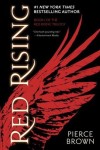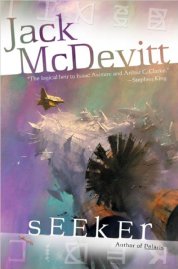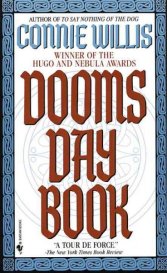Our Teen Librarian, Kelley, shares some of her favorite sci-fi:
 Recently I rediscovered a book that I loved long ago: The Witches of Karres by James H. Schmitz. I enjoyed it just as much, if not more than before. The book is a rarity among older science fiction, it doesn’t show its age with ridiculous predictions or stilted dialog and literally feels as if it could’ve been written yesterday. Partly, I believe that this is because it is as much a fantasy book as a science fiction book, but mostly it’s because the author’s writing is funny, imaginative, and clever, and his characters are delightfully quirky and likeable.
Recently I rediscovered a book that I loved long ago: The Witches of Karres by James H. Schmitz. I enjoyed it just as much, if not more than before. The book is a rarity among older science fiction, it doesn’t show its age with ridiculous predictions or stilted dialog and literally feels as if it could’ve been written yesterday. Partly, I believe that this is because it is as much a fantasy book as a science fiction book, but mostly it’s because the author’s writing is funny, imaginative, and clever, and his characters are delightfully quirky and likeable.
Between the 1940s and the 1970s Schmitz wrote a large number of short stories and several, fairly short, novels. His fiction is characteristically light-hearted, fast-paced, amusing and entertaining. It straddles the SF/fantasy genres, can be equally enjoyed by adults and younger readers, and (very unusual for the time and genre) features female characters who are every bit as strong and interesting as the men. This spurred me on to read more of Schmitz’s work, happily most of which are again available, both digitally and in hard copy, and a lot of it is available online for free. I read all of it- Eternal Frontier, the Agent of Vega story sequence, all of his series set in the “Hub”, and all of the numerous independent tales. Twelve of his stories are available from Project Gutenberg , and more are available from Free Speculative Fiction Online (including the entire full-length novel The Witches of Karres). I loved them all, but I still love Witches best.
 The Witches of Karres was originally a novelette published in the December 1949 issue of Astounding Science Fiction. Schmitz expanded the novelette into a novel in 1966, and it is unusual in being relatively long. As is common with this author, it is set in a far-flung future in which humanity has spread across many planets in a substantial part of the galaxy. The story is about Captain Pausert, an amiable, well-intentioned, but inexperienced young space ship captain who finds himself increasingly embroiled in wild adventures when he rescues a young female slave from an abusive owner. Events snowball from there, and he soon finds that he has purchased three young sisters. But these are no ordinary girls; they are from Karres, the witch world, and skilled in manipulating klatha – the universal force which powers witchcraft. This is the start of a whole series of adventures in which Pausert and his feisty and formidable young allies face multiple threats and problems as a result of attracting the attention of some powerful and dangerous organizations, with the survival of civilization being ultimately at stake.
The Witches of Karres was originally a novelette published in the December 1949 issue of Astounding Science Fiction. Schmitz expanded the novelette into a novel in 1966, and it is unusual in being relatively long. As is common with this author, it is set in a far-flung future in which humanity has spread across many planets in a substantial part of the galaxy. The story is about Captain Pausert, an amiable, well-intentioned, but inexperienced young space ship captain who finds himself increasingly embroiled in wild adventures when he rescues a young female slave from an abusive owner. Events snowball from there, and he soon finds that he has purchased three young sisters. But these are no ordinary girls; they are from Karres, the witch world, and skilled in manipulating klatha – the universal force which powers witchcraft. This is the start of a whole series of adventures in which Pausert and his feisty and formidable young allies face multiple threats and problems as a result of attracting the attention of some powerful and dangerous organizations, with the survival of civilization being ultimately at stake.
And- if you found Witches as utterly funny and charming as I did, you are in luck! The story has been continued by other authors (but are not unfortunately available online for free). The Wizard of Karres, by Mercedes Lackey, Eric Flint and Dave Freer, The Sorceress of Karres by Eric Flint and Dave Freer, and (forthcoming) The Shaman of Karres also by Eric Flint and Dave Freer are direct sequels but were written long after James Schmitz’s death in 1981, the first being published in 2004. The authors make a good job of matching Schmitz’s light and amusing writing style and they pack in enough new ideas to keep readers involved and entertained. These stories are not quite as terrific as the original, of course, but still great fun, as are all the James H. Schmitz stories linked above. I hope you enjoy them as much as I do!
If you enjoy The Witches of Karres, here are some other titles from our downloadable audiobook collection you might like:
- The Long Way to a Small, Angry Planet by Becky Chambers
- Gate Crashers by Patrick S. Tomlinson
- All Systems Red by Martha Wells
- To Say Nothing of the Dog : or How We Found the Bishop’s Bird Stump at Last by Connie Willis
- The Hitchhiker’s Guide to the Galaxy by Douglas Adams (also available as an ebook)
- Rats, Bats and Vats by Dave Freer and Eric Flin
- Pyramid Scheme by Dave Freer and Eric Flint
- Catseye by Andre Norton
- Falling Free by Lois McMaster Bujold
- The Fractal Prince by Hannu Rajaniemi







 x Benedict
x Benedict travel novels. These include
travel novels. These include 











 Project Cain
Project Cain


